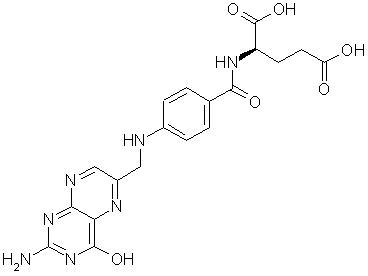

 |
 |
 Folic Acid Crystals Copied without permission from Roche Product Information |
Folic AcidFolic Acid, or pteroyl-L-glutamic acid, is one of the water soluble B-vitaminsDid You Know? Other names for folic acid are folacin, vitamin Bc, vitamin B9 and Lactobacillus casei factor. Top Chemical Structure Fig.1 The Chemical Structure of Folic Acid 3D Structure of Folic Acid Top Principal Sources in FoodThere are many food sources containing folic acid, the most important being:
Folic Acid in the BodyFolic acid is essential in the body for the formation of new cells. It is involved in the metabolism of DNA and RNA, deoxyribonucleic acid and ribonucleic acid respectively, and is required for normal growth, development and fuctioning of the foetus, nervous system and bone marrow.Deficiency of folic acid is quite common and can be caused by inadequate intake, problems with absorption and metabolism or increased requirements. Symptoms of severe deficiency include:
StabilityFolic acid in food is very unstable and considerable losses occur during short storage and cooking.Top |